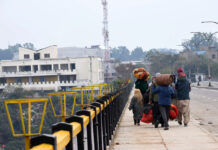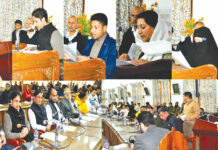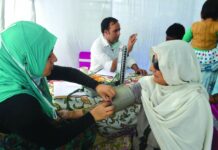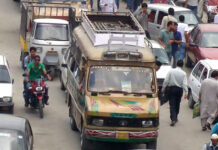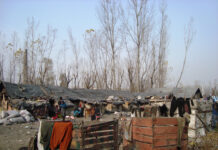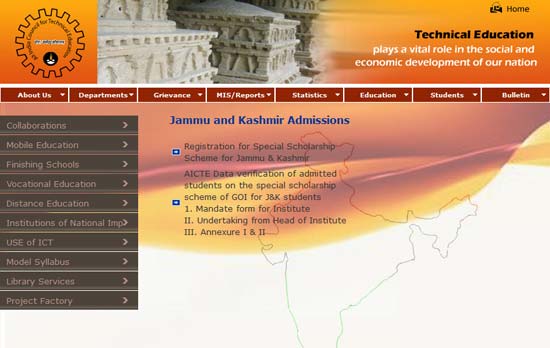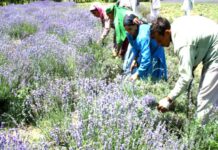 The government is trying anything and everything it can to quell the current uprising and to counter Geelani’s protest calendar. The latest tug of war has put children on the rope. Khursheed Wani reports.
The government is trying anything and everything it can to quell the current uprising and to counter Geelani’s protest calendar. The latest tug of war has put children on the rope. Khursheed Wani reports.
On September 26, School Education Minister Peerzada Muhammad Sayeed convened a press conference at the Education Directorate announcing measures to re-open educational institutions. This was for the first time in three months when the government exhibited concern for children’s education. Peerzada, in an unprecedented way, announced the schedule for examinations and spelled out security measures for ensuring re-opening of educational institutions, particularly in Srinagar city, which has borne the maximum brunt of shutdowns and official lockdowns.
The government opened the schools but kept the curfew on making, political analysts say, children’s education a weapon to counter Syed Ali Geelani’s protest calendar.
Peerzada’s announcement came a day after Chidambaram announced 8-point package for Jammu and Kashmir, which included sanction of Rs 100 crore for enhancing infrastructure of educational institutions. During their separate interactions with media, Peerzada and Chief Minister Omar Abdullah emphasized on re-opening of educational institutions. The latter specifically mentioned his morning meeting with the officers of the education department together with security grid for ensuring reopening of the schools.
On the face of it, the state’s efforts to ensure re-opening of schools were a bold and laudable initiative. But it should have been consistent with the ground situation. When Peerzada’s diktat surfaced, there was a counter-diktat from Hurriyat leader Syed Ali Shah Geelani asking the parents of children not to send their wards to schools. With a double-edged sword hanging on their neck, the people were unable to decide whether to follow the government’s direction or pay heed to separatists’ call.
Experts on conflict situations say that schoolchildren are the most vulnerable lot in the state of lawlessness and anarchy. That is why the government closes down educational institutions during calamities, disasters, riots or any public uprising.
Educationist Ghulam Ahmad Dar says that no right thinking person in Kashmir was in favour of closing down schools and colleges. “We know the consequences of the loss that children suffer due to closure of education institutions. But at the same time, the educational activity requires peaceful atmosphere for both teachers and the taught. Unfortunately, that atmosphere is not prevailing in Kashmir,” he said.
Dar’s observation was evident on June 27 when the schools re-opened on the orders of the rulers. It was a complete chaos everywhere, most brazenly in capital Srinagar. Miscreants targeted school buses, which were promised security by the authorities. Some parents having faith in official announcements, ventured out of homes to drop their children at schools, but they were humiliated and abused by the curfew-enforcing security forces on their return. In the afternoon, the authorities recalled all state-run buses pressed into service for ensuring journey of children and teachers.
For the entire day, and the following three days, top officials of the administration including Deputy Commissioners went to schools and colleges to monitor all-evasive attendance. Worse, the attendance registers were checked by police officers and sleuths of counter-intelligence wing of police. Reports pouring in from remote areas suggest that army personnel also “raided” the schools to monitor the attendance.
Even as the teachers and lecturers, who regularly get salaries from the exchequer, took the challenge, though reluctantly, to reach their places of duty, the attendance of children could not be ensured. Estimates say that the total attendance of students could not exceed 15 per cent. However, the education minister and home minister claimed more than 80 per cent attendance and expressed satisfaction on their initiative.
Why re-opening of schools became an important issue for the government, is the most interesting question. Sources said that the 39-member All Party Delegation (APD) led by Union Home Minister P Chidambaram took note of the gravity of situation emerging from the closure of schools and colleges. “Most of the common people, political leaders and civil society members who met the delegation rued the closure of educational institutions and expressed desire of the common people for re-opening of these institutions to safeguard the future of next generation,” an official who remained closer to the APD told Kashmir Life. This feedback, encouraged the central government to use the opening of schools as a potent weapon to break separatists’ designs to continue the anti-India protests in Kashmir.
There is no denying the fact that the unrest in Kashmir has shattered the academic calendar affecting schoolchildren and students pursuing intermediate and higher studies. However, the showdown between separatists and the government on the issue of schools has complicated the issue. Some observers say that it was better for the government to focus on the law and order issue to pave way for re-opening of schools. “In worst situation, the academic year of the students could have been saved by announcing March session for exams”, said Muhammad Ashraf, a teacher from south Kashmir.
The state of educational institutions is pathetic. In Kashmir University, new postgraduate classes were about to begin when the turmoil started in mid-June. “Most of the new entrants to the university have not even attended the introductory classes,” a senior faculty member said. The round-the-year examination schedule has smashed to smithereens adding to the woes of students. In July, the Kashmir University Vice Chancellor Riyaz Punjabi cancelled all holidays including Sundays to compensate for the academic loss. However, the theoretical measures could not be applied on ground due to the prevailing situation. Worse, the Kashmir University and almost every other premier institution in Kashmir are not fully residential. “The VC announced cancellation of holidays for the sake of self-glorification in the media. Practically, the hostels were locked up and students were asked not to show up in the campus,” an aggrieved student said. The university even facilitated transport for the students evacuating from the hostels.
 The students of lone National Institute of Technology (NIT) are caught in a catch-22 situation. They have to keep pace with 30 other similar Institutes across India and maintain a uniform calendar. “The students have already lost two months. The uncertainty prevails and there is no guarantee that the situation would improve”, said an aggrieved student from the campus on phone, which is located in curfew bound Hazratbal area.
The students of lone National Institute of Technology (NIT) are caught in a catch-22 situation. They have to keep pace with 30 other similar Institutes across India and maintain a uniform calendar. “The students have already lost two months. The uncertainty prevails and there is no guarantee that the situation would improve”, said an aggrieved student from the campus on phone, which is located in curfew bound Hazratbal area.
The NIT authorities say that the routine class work has hampered due to abnormal situation in the valley. “We are trying to make necessary arrangements to save the precious career of the students,” a faculty member said on condition of anonymity.
The situation is no different in Valley’s 36 degree colleges, agriculture university and Islamic University of Science and Technology.
A lecturer who teaches at Pulwama Degree College says that situation in the colleges has touched the worst proportions. “The formal class work was about to begin when the turmoil started. By now we should have been preparing for the examinations but the students have not attended 10 per cent of classes. The science faculties are worst hit. They have not touched the theory part (of syllabus) leave alone the practicals and Project work,” he said.
The authorities issued warnings to teaching staff to ensure regular attendance. Even the administration organized surprise checks in the educational institutions, but the system never worked.
During separatist-sponsored strikes, the lack of transport facility hampers the movement of students and teachers. “The authorities announced that during curfews, identity cards would be treated as curfew passes but the police and paramilitaries never honoured the direction,” said Pir Showkat, a college lecturer from south Kashmir.
Hardline faction of Hurriyat Conference led by Syed Ali Geelani, which spearheads the “Quit Jammu and Kashmir campaign” since June-end has announced closure of educational institutions in its strike calendars. “The bounty of freedom is precious than education and career building. The education can wait till we achieve the goal of freedom”, Geelani said at a press conference recently. Geelani had recently announced to accommodate examination schedule
At many places, volunteers organized free tuition classes at local levels but the unorganized system failed to deliver results. “The volunteers, mostly students and government employees, joined the community schools but they never worked under a system and pattern. Therefore, the system is unlikely to bear any results,” said Villayat Ali, a teacher who worked for a few days in a community school. And, the community schools were run in selected localities where curfew was not imposed rigorously. In 90 per cent localities, particularly in the core of Srinagar city, volatile towns and remote villages, the community schools have not taken off.
However, without denying the importance and necessity of education, keen Kashmir watchers say the government has “stooped to low” in its efforts to counter Geelani’s protest calendar by using children’s “education as a weapon”.
They add that “weapon” was discovered by the APD during its visit to Kashmir on September 20-21. Back in Delhi, Chidambaram asked the state government to launch an offensive against the separatists using the educational institutions of the Valley as the shield. The ground situation in Kashmir, however, suggests that the newly-introduced shield is as fragile as the actual peace in Kashmir.


